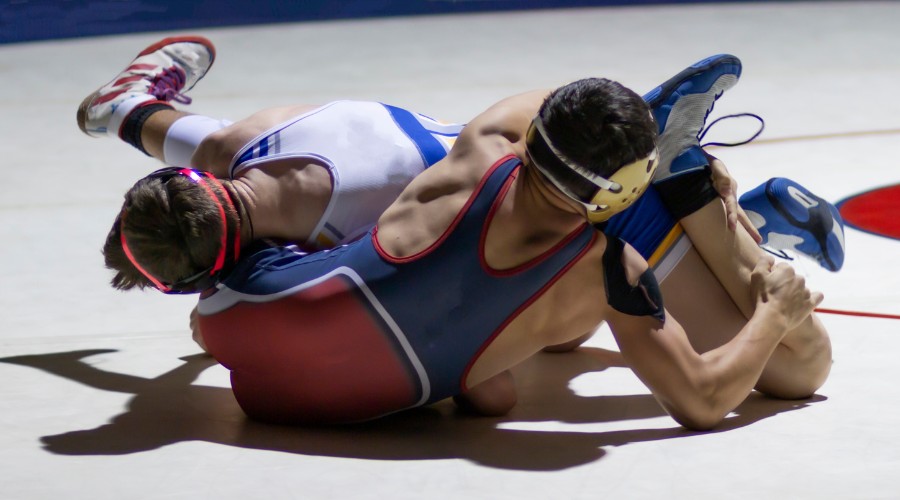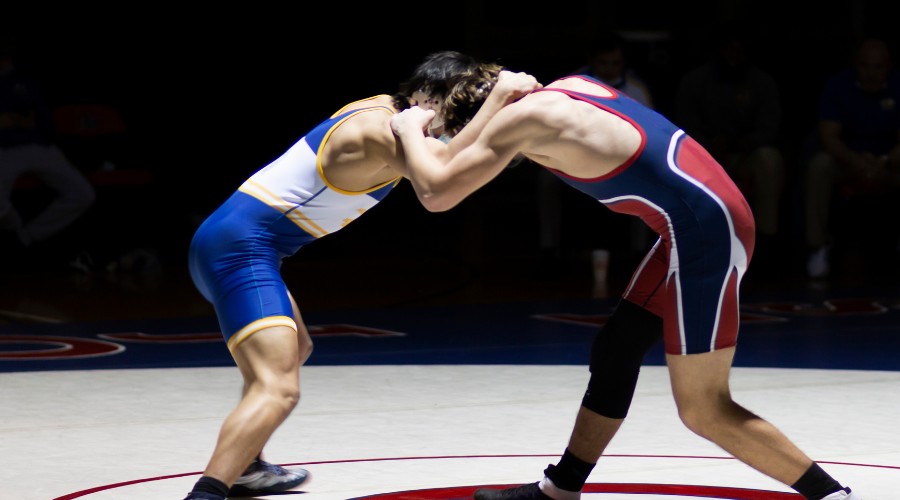Wrestling has been a part of human culture and a way to prove dominance without severely hurting someone since the beginning of time. There are countless styles worldwide, but the most popular ones today are the Olympic disciplines of Greco-Roman and freestyle. In the USA, however, folkstyle wrestling is much more widespread. But what is it?
Folkstyle or collegiate wrestling is the main style practiced in the American post-secondary school system. The main goal is to pin the opponent on his back, and the upper and lower body are open for attacks. The central emphasis of collegiate wrestling is ground control and dominance.
Folkstyle wrestling is a great sport and an essential part of the American sports system. But aside from its independent qualities, it has also proven to be an excellent base for MMA, and despite some noticeable differences, it can also help jiu-jitsu immensely. Do you know how?
What Is Folkstyle Wrestling
Folkstyle wrestling, also known as collegiate wrestling, is practiced in the USA at the high school and college levels. It’s very similar to the Olympic discipline of freestyle wrestling, but it has a slightly different focus and scoring, which makes it a distinct style.
The term folkstyle wrestling is used for native styles of wrestling worldwide, like Turkish Oil wrestling, Indian Kushti, Japanese Sumo, and countless others.
USA’s folkstyle is collegiate wrestling, and for this article, we will use the term folkstyle only in describing this particular style of wrestling.
In folkstyle wrestling, greater importance is placed on dominance and control on the ground rather than on high-amplitude throws and takedowns, which are the main focus of freestyle.
Folkstyle is practiced almost exclusively in America, but its large influence on both no-gi jiu-jitsu and MMA makes it an interesting style for people worldwide.
Like freestyle, folkstyle wrestling has roots in catch as catch can. Catch became a popular pastime and a spectacle, first at fairs and then at the professional level in the 19th century.
But as it became more widespread in gymnasiums and schools, the rules gradually removed all the dangerous holds and submissions to make the sport safer.
As amateur wrestling grew in the early 20th century and new rules and scoring were implemented, more schools and colleges began their programs until 1928, when the first NCAA Wrestling Championship took place. The rules differed significantly from freestyle wrestling, and collegiate wrestling became distinctly American and remains so today.
Main Folkstyle Wrestling Techniques

Folkstyle wrestling has techniques corresponding to the three main positions of the sport.
When in neutral positions, wrestlers aim to take the opponent down, which can be done in many ways, including lower body takedowns like the double and single leg, upper body takedowns like snap down and arm drag, throws including the hip toss and fireman carry, and outside and inside leg trips.
Once the match goes to the mat, the offensive wrestler aims to control the bottom player using ankle and leg rides and breakdowns, ultimately leading to a pinning combination.
The person on the defensive can use escapes like the sit-out and knee slide and reversals like the bridge and roll.
Wrestling is demanding physically, and on top of significant technical and tactical skills, wrestlers must also possess incredible strength, endurance, and mobility to overcome the opposition.
Folkstyle Wrestling Rules
Just like in the other two main styles of wrestling, Greco-Roman, and freestyle, the main goal of a folkstyle match is to pin the opponent’s shoulders to the mat for two seconds, which is called a fall. More broadly, the goal is “physically controlling the opponent against their will without injuring them.”
If no fall is scored, the winner is determined by the accumulation of points awarded for takedowns, escapes, reversals, and near falls. Before we get to the actual scoring, we must understand the main positions during the match.
Neutral Position: When both wrestlers are facing each other on their feet or knees. All matches start at a neutral position.
Offensive Position: The wrestler on top or behind their opponent and controlling them is in the offensive position.
Defensive Position: The person on the bottom and being controlled is in the defensive position.
Here is how points are earned in folkstyle wrestling:
Pin or fall: Victory
Technical superiority: If one competitor leads with 15 points, he wins
Takedown: 2 points
Escape: 1 point- the wrestler in the defensive position manages to escape and return to a neutral position.
Reversal: 2 points- the defensive wrestler manages to get under the opponent’s control and ends up being on the offense.
Near fall: 2 points if you hold your opponent on his back at 45 degrees (one shoulder on the mat) for two seconds; 3 points if you hold your opponent for five seconds or more
Illegal holds and Unsportsmanlike behavior: 1 point for your opponent up to 4
Unnecessary roughness: 1 point for your opponent
Stalling: 1 point for your opponent after you receive one warning; disqualification on the fifth stalling violation.
Wrestlers compete in set weight classes like in other combat sports to ensure fair matches. There are 10 main weight classes, starting at 125 pounds and reaching 285 pounds. In high school, matches are contested in 3×2 minute periods, while for collegiate wrestlers, the first period is 3 minutes, and the second and third remain at 2 minutes.
Folkstyle Wrestling Tournaments

As the name suggests, collegiate wrestling is tightly linked to the school system. The clubs and competitions are all run through it, and there are no hobbyists training and no masters competitions, both of which are very typical of BJJ.
Collegiate wrestling is structured around seasons, typically from October to March. Competitions are most commonly dual meets, where two wrestling teams compete against each other or multiple duals with more teams.
There are also tournaments where wrestlers compete individually in large brackets and earn points for their team. The NCAA has three divisions at the college level, with D1 being the highest level possible.
Folkstyle Wrestling In BJJ
As great a sport as collegiate wrestling is on its own, I am sure most of the readers of this article are more interested in how all of this translates to jiu-jitsu. Wrestling in the USA and most of the world is catered almost exclusively to young people, and once wrestlers graduate, they are left with no place to train and compete.
On the other hand, BJJ has become the perfect sport for hobbyists and people in middle age, and many former wrestlers transition into jiu-jitsu once their college days are over.
Many such people have enhanced no-gi BJJ and even traditional gi jiu-jitsu with many wrestling techniques and concepts. Especially in the stand-up department, classic jiu-jitsu is sorely lacking, whereas wrestling is at its finest.
High-level submission grappling competitions also feature much more wrestling than before, and a well-rounded skillset is necessary for grapplers with ambitions of reaching high-level competition success.
But how does all of this help you as a BJJ practitioner? By implementing some wrestling-style training, you can see immense technical and physical improvements. This does not mean going to a wrestling room; just doing wrestling-style drills and techniques as a part of your jiu-jitsu training will gradually improve your game in the following ways:
- Better takedowns
- Better top pressure and control
- Greater strength and stamina
- Improved scrambling
- More intense mindset
Summary
Folkstyle wrestling is an integral part of the American sports landscape, and the rise of mixed martial arts and jiu-jitsu has increased its already formidable reputation and visibility. Its key characteristic is that it places a big emphasis on ground control instead of the international style, which values throws the most.
If you are into BJJ and looking to improve your stand-up skills, doing some wrestling-style training or, better yet, finding collegiate wrestlers to train with will do wonders for your takedowns and control skills.
